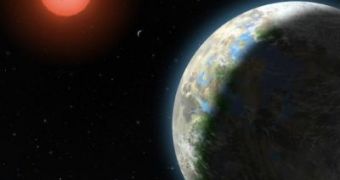A NASA and NSF-funded research, carried out by a team from the University of California Santa Cruz and the Carnegie Institution of Washington, has announced the discovery of an exoplanet, three times the mass of Earth, that orbits a nearby star and is placed in the middle of the star's “habitable zone”.
They have shared the exciting discovery after eleven years of observations, with one of the largest optical telescopes in the world, the W. M. Keck Observatory in Hawaii.
A “potentially habitable planet” is a planet on which life could exist, but not necessarily human life, and this depends on several factors, out of which having liquid water and atmosphere are sine qua non.
And as the planet is placed in an area where liquid water could exist on its surface, the Gliese 581g (named after its star Gliese 581) could be the most Earth-like exoplanet ever discovered.
Scientists have been observing the red dwarf star Gliese 581 for 11 years now, thanks to the HIRES spectrometer on the Keck I Telescope, which allows exact measurements of a star's radial velocity and the discovery of planets orbiting it.
Mario R. Perez, Keck program scientist at NASA Headquarters in Washington, said that “Keck's long-term observations of the wobble of nearby stars enabled the detection of this multi-planetary system.
“Keck is once again proving itself an amazing tool for scientific research,” he added.
The leaders of the Lick-Carnegie Exoplanet Survey were Steven Vogt, professor of astronomy and astrophysics at UC Santa Cruz, and Paul Butler of the Carnegie Institution, and their new findings are reported in a paper published in the Astrophysical Journal.
Vogt said that these “findings offer a very compelling case for a potentially habitable planet [and] the fact that we were able to detect this planet so quickly and so nearby tells us that planets like this must be really common.”
The team actually found two new planets around Gliese 581, bringing the total number of known planets around this star to six, the largest yet discovered in a planetary system outside of our own.
Gliese 581g is three to four times bigger than Earth (it could be a rocky planet with a definite surface and enough gravity to hold on to an atmosphere) and it orbits its star in just under 37 days.
The star is 20 light years away from Earth, in the constellation Libra and has two planets at the hot and the cold limits of the habitable area.
Gliese 581g is tidally locked to the star, which means that it has the same side facing the star, all the time.
Vogt says that an effect of this is to stabilize the planet's surface climates, and the most habitable zone would be the line between darkness and light, or the “terminator”.

 14 DAY TRIAL //
14 DAY TRIAL //